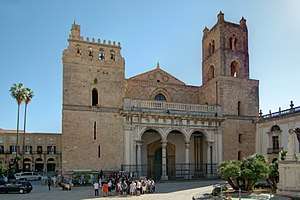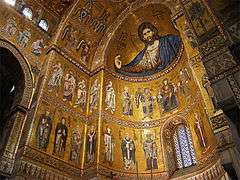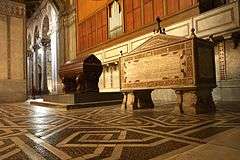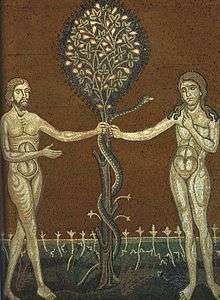Monreale Cathedral
| Cathedral of Monreale | |
|---|---|
 Façade of the cathedral. | |
| Basic information | |
| Location | Monreale, Italy 38°04′54.69″N 13°17′31.44″E (Mappa) |
| Geographic coordinates | 38°04′54.69″N 13°17′31.44″E / 38.0818583°N 13.2920667°ECoordinates: 38°04′54.69″N 13°17′31.44″E / 38.0818583°N 13.2920667°E |
| Affiliation | Roman Catholic |
| Rite | Roman |
| Province | Archdiocese of Monreale |
| Architectural description | |
| Architectural style | Norman, Arab, Byzantine, Renaissance, Baroque |
| Groundbreaking | 1172 |
| Completed | 1267 |
| Official name: Arab-norman Palermo and the cathedral churches of Cefalù and Monreale | |
| Type | Architectural |
| Criteria | ii, iv |
| Designated | 2015 (39th session) |
| Reference no. | 1487 |
| State Party |
|
| Region | Europe and North America |


The Cathedral of Monreale (Italian: Duomo di Monreale) is a church in Monreale, Metropolitan City of Palermo, Sicily, southern Italy. One of the greatest extant examples of Norman architecture, it was begun in 1174 by William II of Sicily. In 1182 the church, dedicated to the Nativity of the Virgin Mary, was, by a bull of Pope Lucius III, elevated to the rank of a metropolitan cathedral. Since 2015 it is part of the Arab-Norman Palermo and the Cathedral Churches of Cefalù and Monreale UNESCO Heritage site.
The church is a national monument of Italy and one of the most important attractions of Sicily. Its size is 102 meters long and 40 meters wide.
History
According to a legend, William II of Sicily fell asleep under a carob tree while hunting in the woods near Monreale. The Holy Virgin appeared to him in dream, suggesting him to build a church here. After removing the tree, a treasure was found in its roots, whose golden coins were used to finance the construction.[1] It is more likely that the church was part of a plan of large constructions in competition with the then bishop of Palermo, Walter Ophamil, who had ordered the large Cathedral of Palermo. The construction of Monreale, started in 1172, was approved by Pope Alexander III with a bull on 30 December 1174.[2] Works, including an annexed abbey, were completed only in 1267 and the church consecrated at the presence of Pope Clement IV.[3] In 1178 Pope Lucius III established the archdiocese of Monreale and the abbey church was elevated to the rank of cathedral. The arcbishops obtained by the kings of Sicily a wide array of privileges and lands in the whole Italian peninsula.
In 1270 Louis IX, King of France, brother of King Charles I of Naples, was buried here.
In 1547-1569 a portico was added to the northern side, designed by Giovanni Domenico Gagini and Fazio Gagini, in Renaissance style, covered by a cross vault and featuring eleven round arches supported by Corinthian columns. In 1559 most of the internal pavement was added.
Description
The archiepiscopal palace and monastic buildings on the south side were of great size and magnificence, and were surrounded by a massive precinct wall, crowned at intervals by twelve towers. This has been mostly rebuilt, and but little now remains except ruins of some of the towers, a great part of the monks' dormitory and frater, and the splendid cloister, completed about 1200.
The latter is well preserved, and is one of the finest Italian cloisters now extant both for size and beauty of detail. It is about 2,200 m2, with pointed arches decorated with diaper work, supported on pairs of columns in white marble, 216 in all, which were alternately plain and decorated by bands of patterns in gold and colors, made of glass tesserae, arranged either spirally or vertically from end to end of each shaft. The marble capitals are each carved with foliage, biblical scenes and allegories, no two being alike. At one angle, a square pillared projection contains the marble fountain or monks' lavatorium, evidently the work of Muslim sculptors.
The church's plan is a mixture of Eastern Rite and Roman Catholic arrangement. The nave is like an Italian basilica, while the large triple-apsed choir is similar to one of the early three-apsed churches, of which so many examples still exist in Syria and elsewhere in the Middle East. It is like two quite different churches put together endwise.
The basilican nave is wide, with narrow aisles. On each side, monolithic columns of grey oriental granite (except one, which is of cipolin marble) support eight pointed arches much stilted. The capitals of these (mainly Corinthian) are also of the classical period. There is no triforium, but a high clerestory with wide two-light windows, with simple tracery like those in the nave-aisles and throughout the church, which give sufficient light.
The other half, eastern in two senses, is both wider and higher than the nave. It also is divided into a central space with two aisles, each of the divisions ending at the east with an apse. The roofs throughout are of open woodwork very low in pitch, constructionally plain, but richly decorated with colour, now mostly restored. At the west end of the nave are two projecting towers, with a narthex (entrance) between them. A large open atrium, which once existed at the west, is now completely destroyed, having been replaced by a Renaissance portico by Giovanni Domenico and Fazio Gagini (1547–1569).

The main internal feature is the large extent (6,500 m2) glass mosaics, executed in Byzantine style between the late 12th and the mid-13th centuries by both local and Venetians masters[4]. With the exception of a high dado, made of marble slabs with bands of mosaic between them, the whole interior surface of the walls, including soffits and jambs of all the arches, is covered with minute mosaic-pictures in bright colors on a gold ground. The mosaic pictures, depcting stories from both the Old and New Testament, are arranged in tiers, divided by horizontal and vertical bands. In parts of the choir there are five of these tiers of subjects or single figures one above another.
The half dome of the central apse has a colossal half-length figure of Christ, with a seated Virgin and Child below; the other apses have full-length figures of St Peter and St Paul. Inscriptions on each picture explain the subject or saint represented; these are in Latin, except some few which are in Greek. The subjects in the nave begin with scenes from the Book of Genesis, illustrating the Old Testament types of Christ and His scheme of redemption, with figures of those who prophesied and prepared for His coming. Around the lower tier and the choir are subjects from the New Testament, chiefly representing Christ's miracles and suffering, with apostles, evangelists and other saints. The design, execution and choice of subjects all appear to be of Byzantine origin, the subjects being selected from the Menologion of Basil II drawn up by the emperor Basil II in the 10th century.
The tomb of William I of Sicily (the founder's father), a porphyry sarcophagus contemporary with the church, under a marble pillared canopy, and the founder William II's tomb, erected in 1575, were both shattered by a fire, which in 1811 broke out in the choir, injuring some of the mosaics and destroying all the fine walnut choir-fittings, the organs and most of the choir roof. The tombs were rebuilt, and the whole of the injured part of the church restored a few years after the fire. The present organ, revised in 1967 by Ruffatti, has six manuals and 102 stops.
On the north of the choir are the tombs of Margaret of Navarre, wife of William I, and her two sons Roger and Henry, together with an urn containing the viscera of Saint Louis of France, who died in 1270. The pavement of the triple choir, though much restored, is a specimen of marble and porphyry mosaic in opus alexandrinum, with signs of Arab influence in its main lines. The mosaic pavement of the nave was completed in the 16th century, and has disks of porphyry and granite with marble bands intermingled with irregular lines.
Two Baroque chapels were added in the 17th and 18th centuries, which are shut off from the rest of the church. The bronze doors of the mosaic-decorated portal on the left side was executed by Barisano da Trani in 1179.
References
- ↑ del Giudice, Michele (1702). Descrizione Del Real Tempio, E Monasterio Di Santa Maria Nuova, di Morreale ... Palermo: Regia Stamperia d'Agostino Epiro.
- ↑ Lello, Giovanni Luigi (1596). Historia della chiesa di Monreale. Scritta da Giovanni Luigi Lello. Rome. p. 100.
- ↑ Mortillaro, Vincenzo (1836). Guida per Palermo e pei suoi dintorni del barone V. Mortillaro. Palermo: Tipografia del giorn. Letterario.
- ↑ Guida d'Italia. Touring Club Italiano.
Sources
- Kitzinger, Ernst (1991). I mosaici di Monreale. Palermo: Flaccovio Editore. ISBN 88-7804-065-7.
- AA. VV. (2004). Il duomo di Monreale - architettura di luce e icona. Abadir.
- Millunzi, Gaetano (1986). Il Duomo di Monreale. Rome: Vivere In.